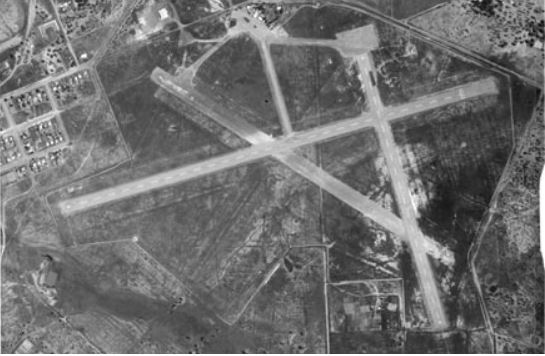No. 4 Aircraft Depot RAAF
From Our Contribution
 Aerial view of Boulder base for No. 4 Aircraft Depot | |
Brief History
No. 4 Aircraft Depot was formed at Pearce on 15 May 1942. At the end of the month it moved to its 'permanent' home, the racecourse at Boulder. Over the following months hangars, barrack blocks and other facilities were built and the adjacent civil airfield was taken over. By the end of 1942 the Depot was ready to start its task of repairing and overhauling aircraft engines, airframes and ancillary aircraft equipment, mainly for RAAF units located in Western Australia. The first aircraft to be worked on were six Brewster Buffalo aircraft from No. 25 Squadron at Pearce. By the end of December 1942 the engine repair workshops had been completed and the first batch of Pratt and Whitney engines had arrived for overhaul. These engines, the overhaul of which was to be a major task for the Depot over the next three years, were used in US Navy and Qantas Consolidated PBY Catalinas as well as RAAF Bristol Beaufort, Douglas Dakota C-47 and CAC Boomerang aircraft. The Catalina engines were sent to Boulder by rail, while those from RAAF aircraft normally came with the aircraft.
By mid-1943 construction of the depot was still not complete, but work on aircraft, engines, and ancillary equipment was proceeding at a rapid rate. By then the Depot strength was 26 officers, 664 airmen and 24 WAAAFs. The main aircraft being overhauled were Beauforts from No. 14 Squadron at Pearce. In late 1943 the facilities were completed, and staffing built up to almost 1,000 personnel, with work overhauling CAC Boomerang aircraft from 85 Squadron at Guildford and Vultee Vengeance aircraft from No. 25 Squadron RAAF at Pearce as well as Bristol Beaufort aircraft from No. 14 Squadron RAAF. Other aircraft also passed through the depot but in smaller numbers.
The repair sections and shops were: engine, propeller, instrument, bombsight, parachute, hydraulic, armament, radio, radar, sheet metal, machine shop, coppersmith, black-smith, carpentry, fabric, welding. fitting and turning, paint shop, salt bath, electroplating and engine test bed. On the flying side there was a flight test section, air traffic control and tarmac servicing. This latter section was kept busy, not only with aircraft being tested and ferried to and from the Depot, but also aircraft transiting between Perth and eastern Australia. In December 1943 the Depot received a ferry pilot. Until that time this task had been carried out by squadron aircrew. The pilot's job was to test fly aircraft after repair or overhaul to ensure that it was fully serviceable for squadron service. Once three or so flights were completed, the aircraft was returned to its unit, either by the test pilot or squadron aircrew, and another aircraft was collected for ferry to the Depot. In 1944 the test pilot averaged 24 per month and 6 ferry flights per month
Towards the end of 1944, when No. 85 Squadron at Guildford was re-equipped with Spitfires, its Boomerangs were ferried to the Depot to be held in fully operational condition in the replenishment pool. This meant that they had to be flown once per week which, with some 20 aircraft, meant that the test pilot had to carry out up to five flights per day over the three months that the aircraft were held on strength. In March 1945 the majority were ferried out to No. 83 Squadron in Queensland. Also at the end of 1944, when 25 Squadron at Pearce was re-equipped with Consolidated B-24 Liberators, its Vultee Vengeances were ferried to the Depot for storage and subsequent disposal.
After mid-1945 the workload of the Depot started to falloff due to a general reduction of operational activity in Western Area and the departure of the Untied States Navy Catalinas from Perth. Following the Japanese surrender in mid-August, work was restricted to the repair and overhaul of currently held equipment. From then until April 1946, when the Depot closed and all facilities were handed over to a care and maintenance unit, there was a steady run down in personnel. In November 1945 the radio, radar, welding, blacksmith, coppersmith, fitting and turning, and electrical sections were closed, followed by the engine repair, airframe repair and general engineering sections 1n January 1946. The care and maintenance unit was closed in April l947.
Unit Personnel
- Robert Alexander MacLean 23 Jan 1943 - 4 Jun 1944
- Alwyn Raymond Liddell 19 May 1943 - 28 Apr 1944
- Nicholas Keating 21 Jun - 8 Sep 1944
- Alfred Ensor Hand 30 Oct 1944 - 3 Jan 1946
- Edward Trayton Elvish 9 Sep 1943 - 15 Oct 1945
- Dulcie May Faulkner 6 Jun - 8 Nov 1944
- William Ramsay Martin 10 Jun 1944 - 30 May 1945
- George Laverick Gordin 13 Jun 1944 - 24 Jun 1945
- Maxwell Kenneth Ottaway 30 Jul - 27 Nov 1945
- Reginald Thomas Blackman 17 Jan - 13 Jun 1945
Trainees
Notes
Content has come from Units of the Royal Australian Air Force - A Concise History - Volume 7 Maintenance Units - Australian Government Publishing Service - 1995